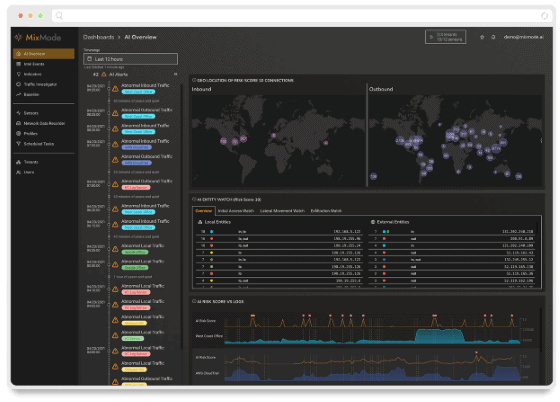It’s that time of year again! As we usher in a new decade, it’s a great time to look ahead to the new trends and cool technologies we might see in the coming years. Will we finally get those flying cars?
At MixMode, we can’t help but imagine the flip side of all that potential. An increasingly connected cyber landscape means an increased number of potential targets for bad actors. New tech is exciting, but it’s often inherently vulnerable to cyberattacks.
One prediction we can make with confidence is that the team here at MixMode will be prepared to handle the security threats of tomorrow. We will continue improving our AI-enhanced security platform to stay ahead of data thieves, ransomware bullies, sophisticated phishers, and yet-to-be-created cyberthreats, too.
These five advanced cybersecurity threats are on our radar for 2020.
1. Phishing Gets Very Personal
Long gone are the days when most employees could spot phishing efforts a mile away. Today’s phishing scam artists have become much more adept at crafting all-too-authentic communications. These tech-savvy criminals are now repurposing data from their last successful breach. Some are using AI that can learn corporate lingo and collecting voice snippets to use in sophisticated phone phishing scams.
HTTPS encryption will become a larger area of concern in 2020, as well. The burden will be on organizations to ensure their employees at large are aware of phishing tactics and that SecOps teams are well-prepared to confront them.
2. Ransomware Grows Up
As if it wasn’t a big enough threat already, ransomware will become more commonplace in 2020. The biggest target? Vulnerable cloud data.
Ransomware has been at the heart of attacks that have threatened to take down cities as large as Baltimore and New Orleans in 2019. Healthcare providers and school districts have faced ransomware threats, as well. These entities often have no choice but to pay the ransom to keep vital services running.
Cybercriminals will likely move beyond DoS attacks to exploiting vulnerabilities, much like the BlueKeep attacks last year. Here, hackers were able to use the BlueKeep exploit to hack into unpatched Windows systems to install a cryptocurrency miner.
3. IoT Becomes a Target
The world is more interconnected than ever, thanks to the “Internet of Things” or IoT. Smart devices have ushered in a whole new world of entertainment and education and have changed the way companies do business. Our connected world makes communication easier but also more vulnerable.
The inherent nature of IoT means that SecOps teams can never fully get a handle on the security capabilities of connected third party devices. It is difficult enough to apply security patches to the company’s own mobile devices.
Hackers have become adept at accessing corporate networks through unsecured IoT devices to install malware. Anti-virus software creator Kaspersky reported that as many as 100 million IoT attacks happened throughout the world in 2019.
Cybersecurity trend analysts at FireEye predicted more attacks like the Reaper attack, where hackers exploited vulnerabilities in IoT devices to install malware. FireEye warned that these bad actors can enlist millions of compromised IoT devices to drive large-scale attacks, including DDoS attacks that can take down entire websites.
4. Insider Threats Increase
As far too many companies can attest to, one of the biggest threats to network safety is employee errors or wrongdoing. In its 2019 Data Breach Investigation Report, Verizon estimated that insider threats are at the heart of a third of all data breaches.
Even cybersecurity firms themselves are not immune from insider threats. Last year, an employee of well-regarded cybersecurity firm Trend Micro illegally accessed and sold customer data to a malicious third party.
2020 will likely bring more breaches caused by employees, whether they are intentional and targeted or the result of simple human error. The issue has become so commonplace that the US Department of Homeland Security has issued a set of guidelines aimed at protecting critical municipal and federal infrastructure networks from insider threats.
5. Adversarial AI Attacks Evolve Alongside Cybersecurity AI
It might seem like a compelling science fiction plot, but the reality is that computers are learning to attack networks on their own. While cybersecurity platforms equipped with smart AI are becoming more and more adept, hackers are using the same technology for nefarious ends.
In a recent CNBC interview, Etay Maor, Chief Security Officer at cyberintelligence company IntSights, said he expects to see the adoption of AI tools for more targeted, automated attacks.
Adversarial AI attacks are especially concerning because they are so efficient. In the past, data theft was more costly to hackers in terms of time and resource commitment. Today’s AI-driven hacks can be carried out across entire networks, multiple times, by programming just a few lines of codes.
Preparing for 2020 and Beyond
In the coming decade, protecting proprietary and personal consumer data will inevitably become a significant concern for any entity with an online presence. Many industry leaders pointed to cybersecurity as the number one threat facing the global economy in a recent survey of CEOs. Forward-thinking enterprises will need to craft thoughtful, strategic plans for their network security.
Serious threats require serious preparation and response. That’s why the MixMode platform harnesses the power of third-wave AI that can create a baseline of complex networks in a matter of a few days. MixMode can predict attacks before they happen and is smart enough to filter out false positives so your security team can focus on real issues.
Don’t panic — prepare. Reach out to the friendly MixMode team to schedule a demo today.
MixMode Articles You Might Like:
Wire Data: What is it Good For?
Yesterday’s SIEM Solutions Can’t Combat Today’s Cyberthreats
Hacking the Hackers: Adversarial AI and How to Fight It
Hacks and Breaches of 2019: A Year in Review
Our Top 5 Cybersecurity Insights from 2019
What Trends Will Shape the Cybersecurity Industry in 2020?
How AI Can Help You Stay CCPA Compliant


